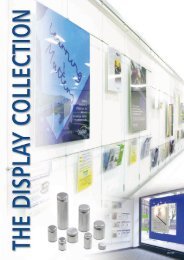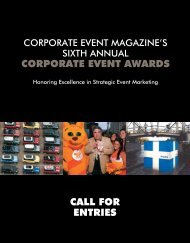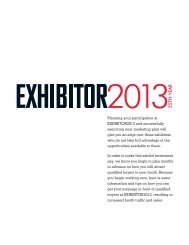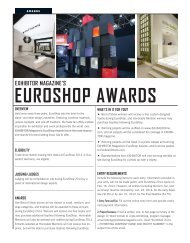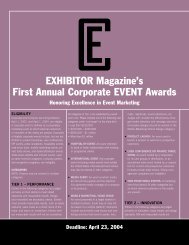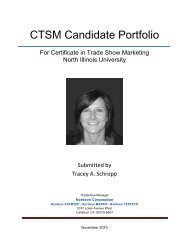application and contract for exhibit space - Exhibitor Magazine
application and contract for exhibit space - Exhibitor Magazine
application and contract for exhibit space - Exhibitor Magazine
- No tags were found...
Create successful ePaper yourself
Turn your PDF publications into a flip-book with our unique Google optimized e-Paper software.
AMERICANS WITH DISABILITIES ACT (ADA) - EXHIBIT COMPLIANCEThe Managing Directors require all <strong>exhibit</strong>ors to complywith their responsibilities to the physically challenged.Exhibits are considered “public accommodations” <strong>and</strong>are subject to the requirements of the Americans withDisabilities Act (ADA). The following are some suggestions<strong>for</strong> accommodating attendees to EXHIBITOR2011who are physically, visually or hearing impaired. Noncompliant<strong>exhibit</strong>ors will be asked to make alterations toremove architectural barriers wherever it is readilyachievable <strong>and</strong> technically feasible, <strong>and</strong> where removalof such barriers does not place an undue financialburden on the company. For more in<strong>for</strong>mation contactthe U.S. Department of Justice ADA In<strong>for</strong>mation Line,(800) 514-0301, or the ADA web site at:www.usdoj.gov/crt/ada/adahom1.htm.ADA.Hearing Impaired• Provide listening systems.• Avoid high noise levels as this is particularly frustratingto people with limited hearing.• Live demonstrations should have printed materials tocomplement oral presentations.• Reserve a front row demonstration seat <strong>for</strong> those withhearing problems.Visually Impaired• Convert text into Braille.• Avoid protruding objects that a visually impairedperson could walk into.• Avoid raised plat<strong>for</strong>ms.• For long meetings with visually impaired customersaccompanied by a seeing-eye dog, have water <strong>and</strong>/ordog food available.• Have large print literature available, or put materialson disk <strong>for</strong> use on computers.• Provide a sound read back <strong>for</strong> people with sight problems,or other audio presentation.• Avoid sharp corners.• Avoid carpet piling, as well as wires <strong>and</strong> “bumps”.• If a presentation is held on the second deck, offer avideotaped version in a lower lounge.Physically Impaired• Entrance width to the booth should be wide enough toaccommodate a wheelchair.• Avoid raised plat<strong>for</strong>ms or provide proper ramping.• Booth catering should be served at a height to accommodatea person sitting in a wheelchair.• Touch screen displays should be reachable bypersons in wheelchairs.• Avoid sharp corners at eye level <strong>for</strong> wheelchair <strong>and</strong>motor skill-impaired attendees.• Avoid carpet piling, as well as wires <strong>and</strong> “bumps”.• If a presentation is held on a second deck, offer avideotaped version in a lower lounge.• Counters <strong>and</strong> displays should be lowered to 34 inches.Staff Training• Train a member of staff in signing <strong>for</strong> hearingimpairedvisitors.• Speak directly at a person with a hearing impairment.Don’t look down.• Let him or her see you speak. Don’t raise your voiceunless asked.• When speaking with a person in a wheelchair sit downso you are at the same eye level.• Talk directly to a person with a disability. Don’t talk tohim or her through a companion.• Let disabled people give you instructions <strong>for</strong> accommodatingtheir needs.• Booth staffers should be prepared to describe whatthe booth contains <strong>and</strong> what a product demo is doing.Sources: EXHIBITOR, Expo <strong>Magazine</strong>, InternationalAssociation <strong>for</strong> Exhibitions & Events








